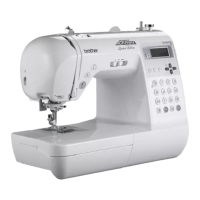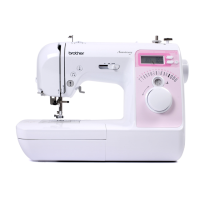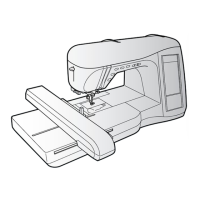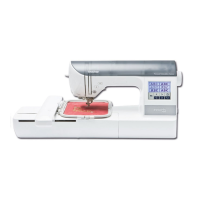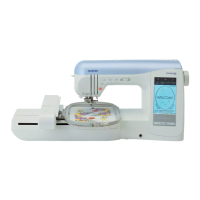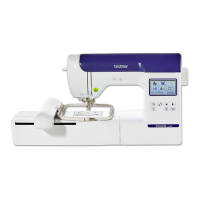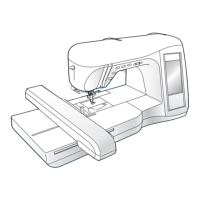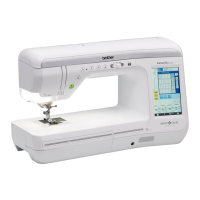Do you have a question about the Brother Innov-Is M280D and is the answer not in the manual?
Crucial safety guidelines to prevent injury, fire, or electric shock during operation.
Specific safety advice tailored for users in the UK, Eire, Malta, and Cyprus.
List of registered trademarks for software and services used with the machine.
Information regarding the inclusion of open-source software in the product.
Identifies and describes the main parts and needle/presser foot sections of the machine.
Lists and describes all accessories that come with the machine.
Lists optional accessories available for separate purchase.
Step-by-step instructions for powering the machine on and off safely.
Explains how to navigate and interpret the machine's LCD screen and its various displays.
Details the functions of various keys and displays on the LCD operation panel.
Describes how to access and change machine settings via the LCD screen.
Guides on adjusting touch sensitivity and winding the bobbin thread.
Instructions for correctly inserting the wound bobbin into the bobbin case.
Detailed steps for threading the upper thread through the machine.
Guidance on selecting appropriate needles and threads for different fabric types.
Instructions for checking and safely replacing the sewing machine needle.
Step-by-step instructions for safely attaching and detaching presser feet.
How to remove and attach the presser foot holder for specific feet.
General guidance and precautions for basic sewing operations.
Core steps and tips for performing basic sewing on the machine.
Covers reverse stitches, combining patterns, automatic stitching, and thread cutting.
Adjusting stitch width, length, L/R shift, and thread tension for optimal results.
Steps for resolving issues with upper thread tension being too tight or too loose.
Tips for navigating corners, sewing curves, and achieving even seam allowances.
Techniques for sewing thick, thin, stretch, leather, and vinyl fabrics.
A comprehensive chart detailing available stitches, applications, and settings.
Basic stitches for general sewing, reinforcement, and decorative purposes.
Step-by-step guide for creating blind hems on garments.
Instructions for sewing buttonholes and attaching buttons with the machine.
Detailed steps for inserting zippers into fabric using different methods.
Techniques for decorative stitching for appliqué, patchwork, and quilting.
How to sew fabric pieces together and perform quilting with various feet.
Includes elastic attaching, bar tacks, darning, eyelets, fagoting, and smocking.
How to use a twin needle for parallel stitching and decorative effects.
Techniques for creating decorative heirloom stitches using a wing needle.
Adjusting stitch patterns for better results based on fabric and tension.
Saving and retrieving customized stitch patterns and embroidery data.
Steps to prepare the machine for embroidery tasks, including foot and unit attachment.
Procedure for safely detaching the embroidery unit from the machine.
Guidance on selecting appropriate threads and preparing fabric for beautiful embroidery.
Techniques for properly hooping fabric and using the embroidery sheet for placement.
Step-by-step process for attaching and safely removing the embroidery frame.
How to browse and select embroidery patterns from memory or USB.
Verifying the embroidery pattern's placement on the fabric before stitching.
Covers selecting character/frame patterns, combining patterns, and editing designs.
Step-by-step guide to embroidering patterns, managing thread changes, and color order.
How to change the display of thread colors and numbers on the screen.
Procedures for handling thread breaks or empty bobbins during embroidery.
How to adjust thread tension specifically for machine embroidery.
Steps for preparing appliqué pieces, including cutting lines and attaching.
Stitching placement lines and attaching appliqué pieces to base fabric.
Creating appliqués using pre-made frame patterns with straight and satin stitches.
Techniques for patchwork and crazy quilt stitching.
Interface for editing embroidery patterns, including size, rotation, and color.
Adjusting pattern size, font style, character spacing, and text orientation.
Screen for adjusting embroidery settings, including pattern position and frame.
Ensuring accurate pattern placement by aligning with fabric marks.
Embroidering multiple character patterns sequentially in a single row.
How to save customized embroidery patterns to memory or USB.
How to load embroidery patterns from memory or USB.
Instructions for cleaning, maintaining, and storing the sewing machine.
Step-by-step guide to cleaning the bobbin area (race) for optimal performance.
Information on factory lubrication, user oiling restrictions, and machine storage guidelines.
Steps to troubleshoot unresponsive or erratic touch screen behavior.
Guide to identifying and resolving common machine operational issues.
Causes and solutions for skipped stitches, irregular patterns, and feeding issues.
Troubleshooting needle breaks, bent needles, and threading errors.
Explains various error messages displayed on the LCD and their solutions.
Instructions for updating the machine's software using a USB flash drive.
Explains the meaning of different beep sounds emitted by the machine.
| Type | Sewing and Embroidery Machine |
|---|---|
| Built-in Stitches | 181 |
| Embroidery Designs | 80 |
| Disney Designs | 45 |
| Sewing Speed | 850 stitches per minute |
| LCD Display | Yes |
| USB Port | Yes |
| Built-in Embroidery Fonts | 10 |
| Automatic Needle Threader | Yes |
| Buttonhole Styles | 10 |
| Speed Control | Yes |
| Presser Feet | 7 |
| Warranty | 3 years |
| Maximum Embroidery Area | 100mm x 100mm |
